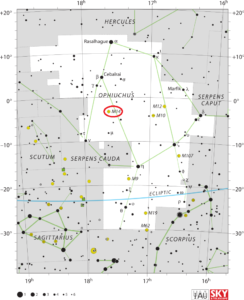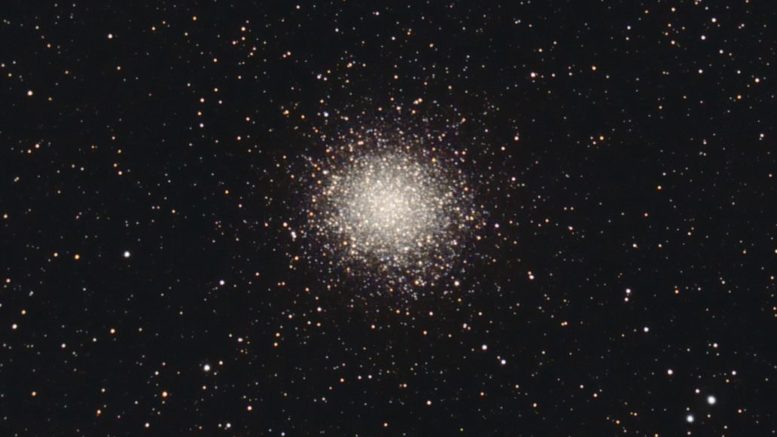Messier 14 is a globular cluster that is 13 billion years old with 150,000 stars, located in the southern constellation Ophiuchus.
| Description | |
| Visible From Pacific Northwest | May, June, and July |
| Best Time To Observe | July |
| Minimum Size Of Viewing Device | Telescope |
| Object Type | Globular Cluster |
| Designations | Messier 14, M14, NGC 6402, BD-03 4142, C 1735-032, GCl 72, HD 159974, GCRV 10179, MWSC 2643 |
| Right Ascension | 17h 37m 36.15s |
| Declination | -03°14’45.3” |
| Constellation | Ophiuchus |
| Absolute magnitude | -9.12 |
| Apparent magnitude | +7.6 |
| Apparent dimensions | 11′ |
| Number Of Stars | 150,000 |
| Distance From Earth | 30,300 light years |
History
The first recorded observations of the cluster were made by Charles Messier, who described it as a nebula without stars and catalogued it on June 1st, 1764.
In 1783, William Herschel observed the cluster and was the first to resolve it into individual stars. As he noted, “With a power of 200, I see it consists of stars. They are better visible with 300. With 600, they are too obscure to be distinguished, though the appearance of stars is still preserved. This seems to be one of the most difficult objects to be resolved. With me, there is not a doubt remaining; but another person, in order to form a judgement, ought previously to go through all the several gradations of nebulae which I have resolved into stars.“
Locating M14 In The Sky
Messier 14 is located 0.8 degrees north and 10 degrees east of Messier 10 and about 21 degrees east and 0.4 degrees north of the star Delta Ophiuchi. It can be found about one-third of the way from Beta to Eta Ophiuchi.
The cluster can also be located along the imaginary line from Cebalrai, an orange giant with an apparent magnitude of 2.76 and the fifth brightest star in Ophiuchus, to Antares, the bright red supergiant located in Scorpius.

Viewing M14
With an apparent magnitude of +7.6, M14 can be easily observed with binoculars. For those using small telescopes, the bright center and faint halo can be viewed, whereas 8-inch instruments will reveal the cluster’s elliptical shape. To resolve individual stars, you will need a 12-inch telescope or larger.
Photographing M14
There are a few sites such as http://astropixels.com/globularclusters/M14-01.html that show how to photograph M14, but there are not many guides for astrophotographers. Accurate guiding will be required, as one doesn’t want to have the stars in the cluster not be crisp and not be defined.
Sources And Further Reading
Descriptions of all of Messier Objects can be found here.
https://www.nasa.gov/feature/goddard/2017/messier-14

Be the first to comment on "Messier 14"